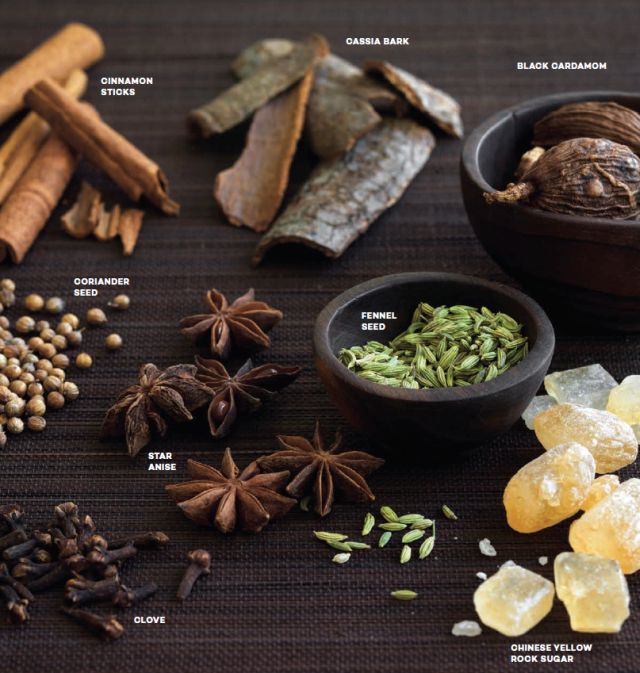
Without doubt, spices play a major role in defining pho. They contribute lots of aroma and flavor to create a multi-dimensional broth. They are subtly there to help express that something is pho-ish. Typical pho spices are warm and sweet, but each has its individual personality.
If this sounds odd, consider the spices that go into chili beans. Now consider the characteristics of Chinese-five spice. The first pho cooks were Chinese-Vietnamese and China borders Vietnam’s northern reaches. You can smell and taste the influence of the Middle Kingdom. (Note: The above image by John Lee is in the Pho book and includes Chinese yellow rock sugar, which is not a spice but a seasoning ingredient.)
Foundational Pho Spices
When you’re leafing through and/or cooking through The Pho Cookbook, you’ll note recurring appearances of certain spices. Pho is not just about star anise, but rather a dance of spices. Here’s a breakdown of what I use and why:
Star anise (đại hồi) defines the broth aroma and flavor with its sweet licorice, slightly bitter notes. Much of the flavor is in the petal-shaped carpels. A whole star anise has about eight of those seed pods (referred to as “points” in recipes). Choose robust points for maximum flavor. Broken star anise is fine.
Chinese black cardamom (thảo quả in Vietnamese) can challenge with its smoky, woodsy, menthol-like qualities but some say it’s the signature pho flavor. Looking like deeply-ridged whole nutmeg, it is sold at Chinese and Viet markets in small plastic packages in the spice section, as well as online.
When shopping, look for the Viet spelling, the botanical name (Amomum tsao-ko), and the Chinese name (cao guo). In a pinch, use the weight equivalent in smaller Indian black cardamom. A medium Chinese black cardamom weighs .07 ounce (2 grams) and a very large one weighs .25 ounce (6 grams). Green cardamom is not the same as Chinese black cardamom.
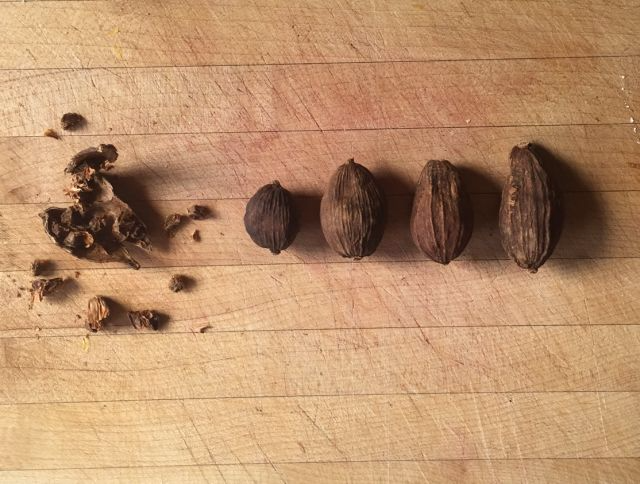
Cinnamon (quế) complements star anise and black cardamom via its warm, earthy, zingy traits. Cassia cinnamon, such as Vietnamese “Saigon” cinnamon, is best for building pho flavor; thank goodness it's the variety commonly sold in America.
Cinnamon sticks are used in these recipes. When substituting irregular pieces of cassia bark from Asian grocery stores (for comparison, see page 21), weigh it to ensure the quantity used: A slender, medium, and husky cinnamon stick respectively weighs .07 ounce (2 grams), .1 ounce (3 grams), and .2 ounce (5 grams).
Clove (đinh hương) plays off star anise and black cardamom, just like cinnamon. The recipes in this book use whole cloves. Select plump ones.
Coriander seeds (hột ngò) round things out with their delicate, citrusy personalities. Spherical coriander seeds work well for pho; football-shaped ones are too sweet.
Fennel seeds (tiểu hồi) serve a similar purpose to coriander seeds by adding a refreshing sweet lilt.
Pepper (tiêu) is often sprinkled onto pho bowls during assembly to add zingy heat. If possible, keep a small jar of freshly ground black pepper in the kitchen. Buy whole peppercorns and use a coffee grinder dedicated to grinding spices. After each use, grind 2 teaspoons raw rice to clean the grinder. White pepper is not used much for pho.
How and where to purchase spices for pho?
Buy whole spices to harness them at their peak. Keep them frozen, if your stash is large. Purchase them where there is a quick turnover, such as an Asian market (Chinese, Southeast Asian or South Asian) or a health food store’s bulk spice section. For example, here’s what I recently picked up at a Chinese-Vietnamese market:
With exception to the black cardamom, the remaining pho spices are sold at regular supermarkets and health food stores. Bulk bins are great but do make sure the spices smell fresh. I get Tellicherry peppercorns from Costco and Vietnamese cinnamon sticks online (I share them with my mom!).
Fine Tuning Pho Spice Notes
Professional pho cooks who are preparing huge batches for a restaurant add pho spices toward the end of the cooking process because they’re simmering for a long time (it takes hours to bring a humongous pot of water and ingredients to a boil). Plus, many pho shops make a concentrate and then dilute and season their broth for service.
Home cooks are small batching artisanal pho. The pho pro approach is unnecessary. While writing The Pho Cookbook, I made many batches and realized that pho spice notes are strongest in the first 72 hours after cooking. Given that, if the spices notes seem weak or you want to adjust the flavor, bring the strained broth to a boil and add more spices (pick one or two and use about 25 percent of the original amount); turn off the heat, cover and let steep for 1 hour before removing the spices and finishing the seasoning. Make a note in your recipe for the future.
Pho spices vary from cook to cook, and also featured proteins and vegetables in the broth. After making pho a few times, I bet you'll have your personal pho spice blend.
If you have pho questions, let me know and I'll try to answer them. In the meantime, in case you subscribe or see the May issue of Cooking Light, this is inside!
Hooray! Thanks for the ongoing pho <3.













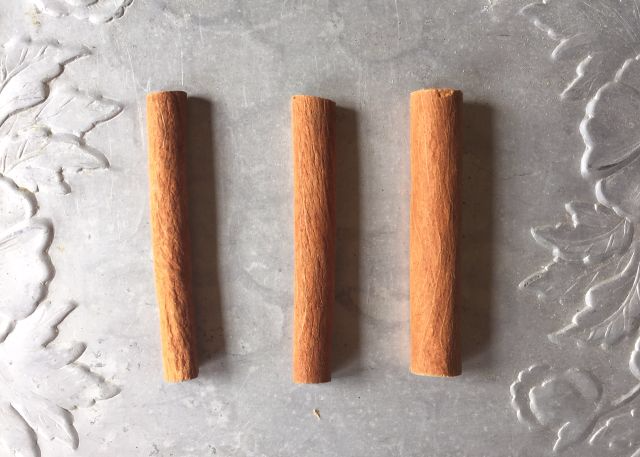
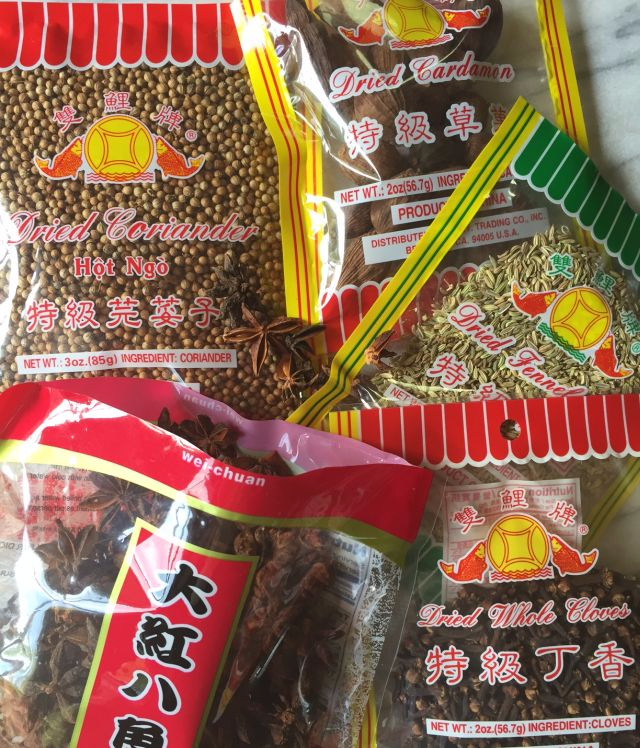
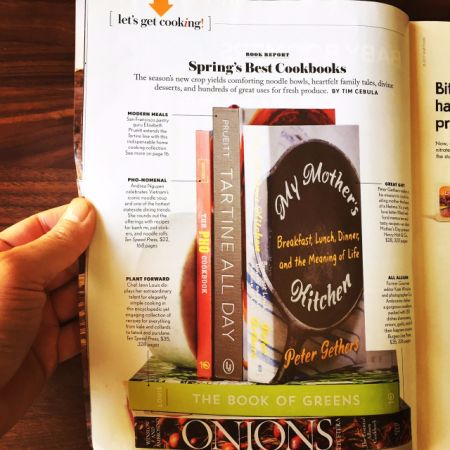

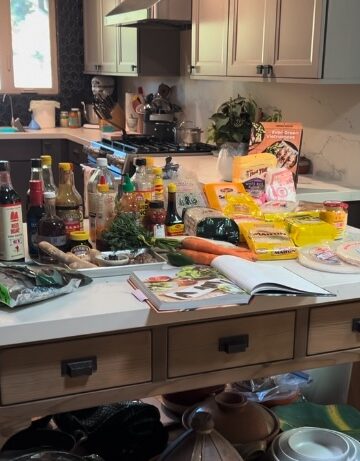
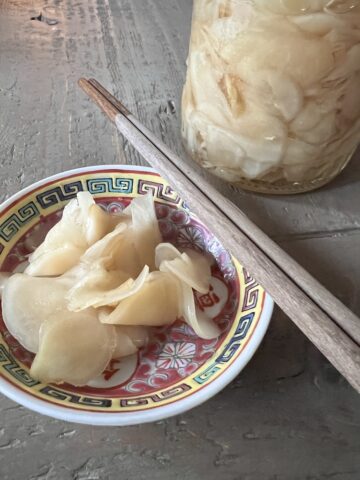
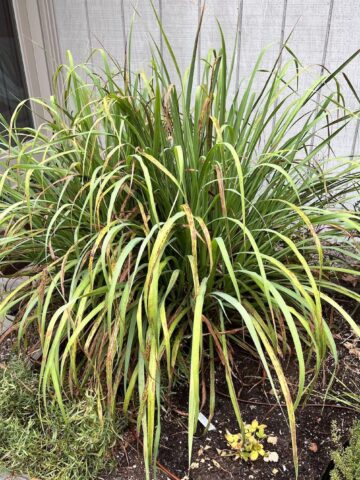
Nicole says
This was a great tutorial to spices. I've made roughly six batches of pho, and quickly learned how the technique and variety of spices used can make such an impact.
I've been using the pre-mixed pouches of pho spices, but I am wondering if there is reason for me to deter from that method. Do you have any thoughts on those?
Do you toast and crush your spices before placing them in cheesecloth? I've been removing a few of the seeds from the black cardamom, toasting, and crushing them. I definitely noticed the smokey notes they add. I've also added fresh cinnamon stick on top of the cassia bark. I don't really understand the differences between the two, but the cinnamon sticks seem to have more "bite" to them when I compare by smelling them.
Thank you!
Andrea Nguyen says
I don't use the pre-mixed spices because I don't know how old they are or where they came from. I choose my ingredients wisely to make food that I like. If you like the pouch then stick with them. They're not for me.
I toast the spices per the cooking method. In the pressure cooker, yes. In a stockpot, no. It depends on the recipe you're using. I follow the recipes in my book, The Pho Cookbook. I do not wrap the spices in cloth or put them in a mesh ball.
Where are you getting fresh cinnamon stick? I only see dried ones. That's so interesting.
Sylvia says
Hello,
I have a good friend who has a cinnamon allergy. Is there a different spice you are aware of that i could substitute in to get close?
Andrea Nguyen says
Maybe omit it and increase the star anise by 1 whole one and the coriander seeds by 25%?
Kyle says
Have you ever tried making an extract from pho spices in alcohol? To use to add that fragrance to instant pho’s
Andrea Nguyen says
I've not tried that. I have made a pho spice blend. It's in my Pho Cookbook and I shared it on this site.
https://www.vietworldkitchen.com/blog/2017/05/pho-spice-blend-recipe.html
George says
Im unclear. So you grind the spices and sprinkle on the pot instead of using whole spices in a pouch? Pros and cons please?
Andrea Nguyen says
No, this is just a spice blend that I use for non broth applications. For example, I use it for making pho meatballs. It's in a pho pot sticker filling. Use whole spices for pho broth. Thanks for asking.
Donald duMas says
Thank you for your excellent tutorial! You mention that some professional cooks make a pho spice concentrate and add it to their broths as needed. Do you have a recipe for one that you would share with us? I ask this because I am a multi-cultural foodie and make my basic cooking stocks and broths in gallon+ quantities and it would be really helpful to be able to flavor them as needed. Thank you again Andrea.
Andrea Nguyen says
You mean a pho broth concentrate. I'd just cook the broth down and then dilute. My mother simply dilutes pho broth I make and then seasons it with fish sauce, Chinese rock sugar, and MSG. I make a strong broth. So just add water to yours and season it like she does. Viet pho restaurants do the same.